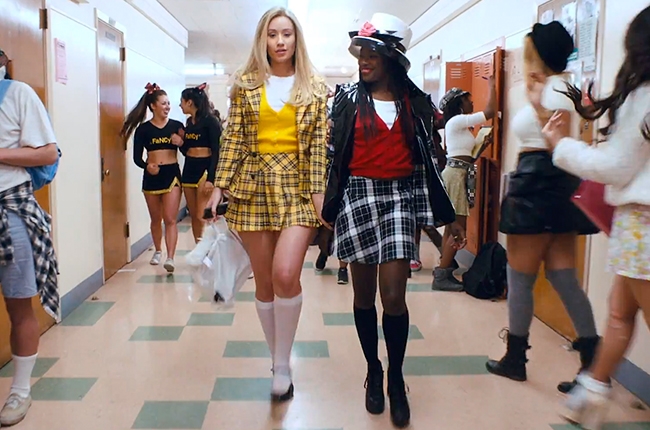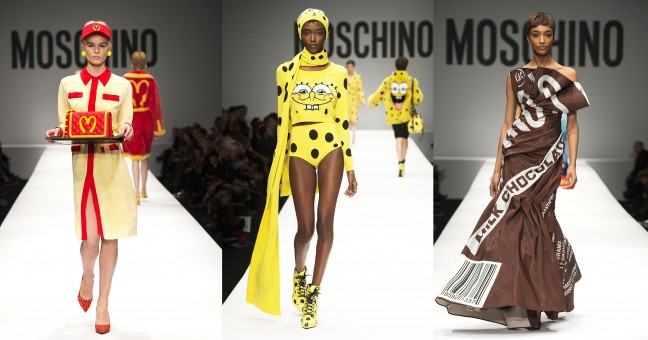VLOG from Tiffany Potashnyk on Vimeo.
Tag Archives: Assessments
Assessment 1: Ugh! As if you used Pop Culture to make Pop Culture
On March 4th, 2014 Iggy Azalea released her music video for the song ‘Fancy’ (Director X, 2014) inspired by the 1995 American film Clueless (Amy Heckerling, 1995). The trailer depicts Azalea as Cher Horowitz (Alicia Silverstone), a Beverly Hills socialite, and features artist Charli XCX as her friend Tai Frasier (Brittany Murphy). After the release, the song went on to become Billboard’s ‘Song of Summer’ 2014 and the video has been viewed over 500 million times on YouTube. The re-enactment of Clueless within the video helps to promote the song into popular culture and forge the identity of Azalea.
Clueless has become a, “90’s cult classic” (Madden, S; 2014), therefore by choosing to re-create scenes from the film the song taps into an already established fandom that has made the film a part of their discourse. The recreation of key moments displays how culture is a, “process we participate in” (Takacs, S; 2015, p.3), as it rewards those who are able to make the connection to Clueless while educates those who don’t know its relevance. The clip uses nostalgia to gain interest and takes advantage of this vulnerability to fulfil it’s, “commercial agenda,” (Railton, D & Watson, P; 2011, p.2) for example, the electronic closet at the beginning of the video has ‘REVOLVE’ sprawled across the screen, the same name and font of an actual online store.
In the video Azalea uses the iconic character of Cher as a platform to build her own identity. Diane Railton and Paul Watson argue that our identity, “…is a product of our specific social, cultural and historical situation” (Railton, D & Watson, P; 2011, p.20); therefore by acting as Cher, Azalea situates the audience’s understanding of the character to develop herself. Through, “subtle changes,” such as the attitude she exudes in her body language when she struts down the corridor and the, “confiden[ce] and sex appeal,” she elicits when stretching at the tennis court, she establishes her existence as a rap music artist (Lyne, C; 2014). Therefore, this re-enactment is not just a, “wholehearted love letter to a titan of pop culture,” (Lyne, C; 2014) but a ploy that uses Clueless to gain worth and propel the product and artist into current popular culture.
References
Lyne, C 2014. ‘Clueless: the classic teen movie that continues to inspire,’ The Guardian (Film Section): http://www.theguardian.com/film/2014/mar/07/clueless-classic-teen-movie-iggy-azalea, March 2015.
Madden, S. ‘Iggy Azalea’s ‘Fancy’ Video Is Basically An Exact Replica of ‘Clueless’,’ MTV, 2014: http://www.mtv.com/news/1723476/iggy-azalea-fancy-charlie-xcx-clueless/, March 2015.
Railton, D & Watson, P 2011. ‘Music Video and the Politics of Representation,’ Edinburgh University Press, Edinburgh, pp.1-40.
Takacs, S 2015. ‘What is Popular Culture?’ (Chapter One), Interrogating Popular Culture: Key Questions, Routledge, New York, pp.1-17.
Popular Culture Example 3: “It’s like when I had this garden part for my father’s birthday”
Cher Horowitz (Alicia Silverstone) is a Beverly Hills socialite who’s attractive, popular and wealthy – her character from the “90’s cult classic” (Madden, S; 2014), Clueless (Amy Heckerling, 1995) has become a symbol of popular culture after, “searing itself into the hearts, minds and elaborate vocabularies of a generation” (Lyne, C; 2014). Inspired by the American film Iggy Azalea released her music video for the song ‘Fancy’ (Director X, 2014) on March 4th, 2014 with the trailer depicting Azalea as Cher and featuring artist Charli XCX as her friend Tai Frasier (Brittany Murphy). After the release, the song went on to become Billboard’s ‘Song of Summer’ 2014 and the video has been viewed over 500 million times on YouTube.
The ‘Fancy’ music video employs Clueless to make the product more appealing to viewers and create a platform for Azalea build her identity as an artist. Diane Railton and Paul Watson argue that, “our identity is not something that comes from within… it is a product of our specific social, cultural and historical situation” (Railton, D & Watson, P; 2011, p.20). Consequently, by paying homage to the film in her music video Azalea identifies herself as a follower of popular culture like the audience. And through acting as Cher, she identifies with the character traits to build the identity of a relatively unknown artist. Similarities to character are created through the use of iconic clothing, such the yellow plaid ensemble, and recreation of key scenes from film, like the highway driving lesson.
However, an identity can also relate to a person’s differences, which the video uses to separate Azalea from the character and forge her existence as a rap music artist. This can be seen in “subtle changes,” such as the attitude she exudes in her body language when she struts down the corridor and the, “confiden[ce] and sex appeal,” she elicits when stretching at the tennis court and in the tighter and more revealing clothes than the original character depicted (Madden, S; 2014). Therefore, this re-enactment is not just a, “wholehearted love letter to a titan of pop culture,” (Lyne, C; 2014) but a ploy that uses nostalgia to gain interest and takes advantage of this vulnerability to fulfil it’s, “commercial agenda” (Railton, D & Watson, P; 2011, p.2).
References
Lyne, C 2014. ‘Clueless: the classic teen movie that continues to inspire,’ The Guardian (Film Section): http://www.theguardian.com/film/2014/mar/07/clueless-classic-teen-movie-iggy-azalea, March 2015.
Madden, S 2014. ‘Iggy Azalea’s ‘Fancy’ Video Is Basically An Exact Replica of ‘Clueless’,’ MTV: http://www.mtv.com/news/1723476/iggy-azalea-fancy-charlie-xcx-clueless/, March 2015.
Railton, D & Watson, P 2011. ‘Music Video and the Politics of Representation,’ Edinburgh University Press, Edinburgh, pp.1-40.
Popular Culture Example 2: When McDonald’s and SpongeBob invade the catwalk
Fashion designer Jeremy Scott’s takeover of the Italian luxury fashion house Moschino in October 2013 as creative director saw the brand morph into a company inspired and well aware of popular culture. The Fall/Winter 2014/15 show used pop culture and fast food as inspiration, with tribute to, “everyone’s favourite all-American guilty pleasure,” McDonald’s, Budweiser, truck-stop snacks and SpongeBob Square Pants (Hyland, V; 2014). The capsule collection was made available immediately online and sold out within 24 hours, prompting a form of fast fashion where aside from celebrity praise in the form of Miley Cyrus, Rihanna and Katy Perry, the popularity of the collection can be linked to the iconic subjects it uses.
Fashion has the ability to turn, “…the body into a discourse, a sign, a thing,” allowing ourselves to be exposed, “to grotesque openings toward the world,” (Hancock, Joseph H, Johnson-Woods, T & Karaminas, V, 2013; p.xii) where the influence can be bought and worn. The saleability of the Moschino collection is somewhat self-generated by the convergence between two areas of popular culture: fashion and subject matter. This merging on one level displays popular culture through fashion, but on another it articulates an understanding of popular culture that is extended to the consumer who buys the product.
Fiske notes, “the mundane is the crucial site of cultural significance, for the mundane is the only terrain upon which popular culture can be made to matter” (Fiske, J; 1995, pp.330). The collection’s use of popular codes that have become ordinary within society, such as the McDonald’s ‘M’, re-purposes their existence in culture prompting an appreciation for them and in turn a deeper connection to the consumer. Each piece also encodes, “social meanings about gender, sexuality and identity,” (Hancock, Joseph H, Johnson-Woods, T & Karaminas, V, 2013; p.xi), in the manner they were designed. The Hershey’s dress, flows like melted chocolate but also embodies the idea of treating yourself as you would on a ball or night out and the McDonald’s bag is an everyday accessory for the everyday kind of food that comes in a bag. These items encode cultural meaning so they can, “serve the interests of the people” (Fiske, J; 1995, pp.322).
References
Fiske, J. ‘Popular Culture,’ in Lentrichchia, F & McLaughlin, T 1995. Critical Terms for Literary Study, The University of Chicago Press, Chicago, pp.321-335.
Hancock, Joseph H, Johnson-Woods, T & Karaminas, V 2013. ‘Introduction’ in Fashion in Popular Culture: Literature, Media and Contemporary Studies, Intellect, UK, pp. xi-xvi.
Hyland, V 2014. ‘At Moschino, Jeremy Scott turns Pop Culture Trash into Sold-Out-In-Minutes Treasure,’ Elle Magazine: http://www.elle.com/fashion/a14689/jeremy-scott-for-moschino-profile/, March 2015.
Popular Culture Example 1: Put some Coconut Oil on it!
Stacy Takacs notes that culture is the, “active process of generating and circulating meanings and pleasures within a social system” (Takacs, S. 2015, p.3), with the strand of Popular Culture identifying the, “ways that mass cultural texts, objects, and performances are created, circulated, and received by individuals in their everyday lives” (Takacs, S. 2015, p.8).

Having visited a health food store recently it was startling to see how many products made of coconut were available, the most prominent being the several choices of coconut oil. Coconut oil has turned into a health food trend with endorsements from nutritionists claiming it plays a positive role in preventing disease (Jacob, A. 2013), to celebrities like Gwyneth Paltrow who gargles it in her mouth for fresh breathe and Channing Tatum rubbing it all over his wife’s pregnant stomach (Hou, K. 2014). These, “popular… people and their practices of creation, interpretation, and agency,” (Takacs, S. 2015, p.8) appropriate the commodities usefulness within society. Thus by sharing what they use the oil for they provide a, “culture… embodie[d]… in the things people do with the commodity,” and, “excorporate,” the artefact within society to make it popular (Takacs, S. 2015, p.6).
The concept of using coconut oil for wellbeing is not new within certain cultures as it’s been a, “staple in tropical regions of the world for thousands of years” (Jacob, A. 2013). What’s surprising is how it’s recent accent into popular culture through celebrity and health outlets has led to a response in the market to introduce more products, therefore, “transform[ing]… cultural traditions into commodities that can be bought and sold” (Takacs, S. 2015, p.2). The products health benefits also has the ability to overshadow its material value allowing consumers to get disillusioned in the craze and forget the intention for, “mass-production [of] commercial profit by centralized cultural industries” (Takacs, S. 2015, p.4-5).
References
Hou, K 2014. ‘25 Weird Things Celebrities Have Done With Coconut Oil,’ The Cut – New York Magazine: http://nymag.com/thecut/2014/10/25-things-celebrities-have-done-with-coconut-oil.html, March 2015.
Jacob, A 2013. ‘Coconut Oil – Learn More About This Superfood That Contains Healthful Saturated Fats,’ Today’s Dietitian, vol.15, no.10, p.56: http://www.todaysdietitian.com/newarchives/100713p56.shtml, March 2015.
Takacs, S 2015. ‘What is Popular Culture?’ (Chapter One), Interrogating Popular Culture: Key Questions, Routledge, New York, pp.1-17.
Integrated Media 01 – Final Korsakow Project
Korsakow Film: Street Disposition
Makers: David Lo Monaco, William Ho and Tiffany Potashnyk
Essay Link: Street Disposition Film Essay
Integrated Media 01 – Film Essay – Street Disposition
A great deal of inspiration for this Korsakow project was derived from the website Humans of New York, a blog turned best-selling book created by Brandon Stanton in 2010 to create, “an exhaustive catalogue of New York City’s inhabitants” (Humans of New York, About). On the about page of his blog Stanton notes how his initial project changed when he started collecting quotes and short stories from the people he met, including these snippets alongside the photographs. “Taken together, these portraits and captions became the subject of a vibrant blog… with daily glimpses into the lives of the strangers in New York City” (Humans of New York, About). Street Disposition is driven on this notion and the project is based around the interaction with the people of Melbourne, whether they be the people we know, or the strangers we would never meet if we didn’t stop and pay an interest in their lives. We believe this subject matter is a perfect theme for Korsakow, as there is a, “focus more on the stories, [and] not just the composition behind the photo,” (Green, J, 2011) therefore creating a collection of ideas and moods rather than a visual statement about what Melbourne ‘is’.
In our film we talk to the people of Melbourne, hearing their stories, moments and comments, and accumulate them to show how Melbourne is a character in itself. This is achieved through overlaying people’s audio to videos of Melbourne; giving the audience an immersive relationship with audio, and observational relationship with video. We wanted to capture the interesting characters on the street, then take these people and link them through space and place, appropriating their comments or character to scenes of Melbourne. In development we thought the best way to achieve our goal was by asking people in Melbourne a series of questions the primary being, ‘What is your fondest memory of Melbourne?’ Through this we introduced a type of constraint to get the direction of the interviewee’s responses on the same page. A question like this gets a reflective and nostalgic way of talking from the speaker as we listen to their story, making the narration a lot more personal to the audience. We were intrigued with the fact everyone has a story and through this project wanted to appreciate all those little things that come to together to make Melbourne the city it is, and highlight that it’s the people that keep Melbourne a constant discovery with a myriad of stories, thoughts and emotions.
In order to correctly portray Melbourne in its vast diversity, we centered our film on obtaining footage of as many various different locations as possible. Upon editing our film we also decided that if we were to include more than one shot of the same landmark or area it would need to be from a completely different angle as well as being filmed from another group member, in order to accentuate the notion of the range of lifestyles, cultures and ethnicity within Melbourne. By having more than one person capture the same scene we hoped to ensure that many interpretations and perceptions of the city were represented. We also took an unconventional approach with piecing the audio with the visuals we had captured, as we consciously filmed all the photography first and then once that process had been completed we recorded all the interviews. In doing this we then created another process of having to draw links between qualities that had been filmed to what had been subconsciously expressed by our participants. This idea was inspired by our experiences of having patterns noticed by others when showing our individual sketch films earlier in the year, as we aspired to recreate this practise and ultimately ending up with a more organic product. Lastly in post-production we chose to include ourselves in the aural landscape, predominantly through clips of us interacting with the recorded subjects, adopting what Bill Nichols would describe as the Participatory Mode in his taxonomy of documentary, where “the filmmaker… interact[s] with his or her subjects rather than unobtrusively observe them” (Nichols, B, 2010).

The use of this mode is mostly applicable to the interview of the old Italian lady, where we portray the rapport we built through the inclusion of the interviewer asking, ‘What was the first thing you remember seeing in Melbourne?’ and therefore demonstrate the difference interactions we had with people and enhanced a sense of community.
The diverse range of demographics as interview subjects was an important aspect of the project; to show aurally, that different ages have different relationships to the city over time, and visually how there are a multitude layers to the city in such things as art and culture. However, there are some common themes developed in the project, one being time – seen in the multiple shots of clocks, for example Melbourne Central and Flinders Street – something we didn’t set out to do intentionally but when compiled all our footage at the end, noticed that the city’s most populated areas are built around the idea of time. The concept of strangers is also a common occurrence, as the audience does not know the voices they hear, but the stories have the ability to be personal and there is an interesting association in appropriating people’s voices we don’t know to fit to places we may be familiar with.

Street art and many other variations of art are also a very conscious recurring element in our film, as we wanted to acknowledge the artistically friendly environment that this city is. In various SNUs we have different representations of Melbourne art like the murals of graffiti, street performers, restaurants, galleries and concert venues. All of these mentioned themes and patterns contribute in expressing Melbourne in it’s multiplicity, and the lack of order to which these images and stories become an option for the user absorbs the ideal of spontaneity and haphazardness of the city scape.
In interface design, we decided not to include a text thread, as we wanted the audio to be the primary link to the video. Furthermore we believe the addition of a text thread would have created confusion for the audience, and there would have been the potential of them getting lost in the interface instead of sitting and listening. We also decided not to place the title of the project in the Interface design, but to create an opening title video in the form of a start SNU to play at the beginning of the piece.
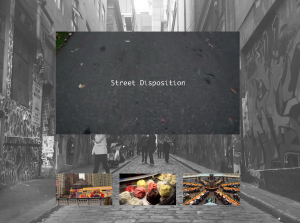
The opening SNU displays footage of a footpath with the natural sound of the street, the title ‘Street Disposition’ then fades on to the screen and is positioned there until the clip ends and the viewer clicks on a thumbnail option. This decision acted as a foreshadowing element to the whole project, as the lack of visuals emphasies the audio, an imperative sensory element used throughout our piece. The title ‘Street Disposition’ also explains the project on two levels, the word Street relating to Melbourne and Disposition to character – therefore the character of Melbourne. The font choice was based on it’s timelessness, but also artistic quality, portraying an almost street art aesthetic in the formation of the words.
In the background, we decided to use an image of a black and white laneway within the streets of Melbourne for a combination of reasons. On a completely shallow base it is quite aesthetically pleasing especially in the way that the lines of the footpath lead the viewers eyes to the main SNU, and makes the loading of videos interesting as there is always an image to look at. There is also the fact that Melbourne’s alleyways are a very iconic feature of the city, which was even commented on during an interview with a tourist. However, the main reason why we decided to include the image of the alleyway was due to the connotative meaning it has of leading the viewers down the path of further discovering Melbourne, acknowledging motifs present within the audio of finding hidden bars, restaurants and alleyways. The fact the alleyway we chose was Hosier Lane was certainly no coincidence as it perfectly conveys a sense of being a locale which houses and nurtures art, which is a theme that is rife throughout our film.
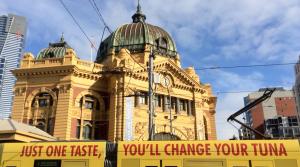 It should be noted that in some videos there is no audio accept that which resides in the clip. This was an intentional decision based in the development of our project where people we shared the project with expressed their appreciation for these clips or even breaks between the stories, allowing them to recollect their thoughts. The choice of clips was strategically based, as we decided to use the famous places or even ‘tourist attractions’ within Melbourne as the basis of this aesthetic. We drew this conclusion as these places are so well known that there is a high probability the user has been there, and consequently has their own stories for these sites. Therefore it prompts the viewer for a moment of reflection, inadvertently asking them to participate in the piece and, “to play a role in the story” (Soar, M, 2014; p.160). We also believed if we were to place audio over these images it may become too ‘promotional’ and get caught up with promoting Melbourne instead of trying to express it, and by portraying these locations ordinarily we have been able to reinforce the idea Melbourne is a place beyond the poster landmarks.
It should be noted that in some videos there is no audio accept that which resides in the clip. This was an intentional decision based in the development of our project where people we shared the project with expressed their appreciation for these clips or even breaks between the stories, allowing them to recollect their thoughts. The choice of clips was strategically based, as we decided to use the famous places or even ‘tourist attractions’ within Melbourne as the basis of this aesthetic. We drew this conclusion as these places are so well known that there is a high probability the user has been there, and consequently has their own stories for these sites. Therefore it prompts the viewer for a moment of reflection, inadvertently asking them to participate in the piece and, “to play a role in the story” (Soar, M, 2014; p.160). We also believed if we were to place audio over these images it may become too ‘promotional’ and get caught up with promoting Melbourne instead of trying to express it, and by portraying these locations ordinarily we have been able to reinforce the idea Melbourne is a place beyond the poster landmarks.
Upon looking at our film in context of the pattern, content and interface it seems very clear to us that our film is about the vibrant, spontaneous, explorative and unexpected nature of Melbourne, filled with a communal sense of creating and gathering art both low and high. This can be seen through recurring themes graffiti, street performance art, musical performance centers like the Forum and the Art Center, locations which cultivate high art like the National Gallery as well as culinary experiences of Melbourne, reinforced by our interface which leads the audience to an unexpected place. This is paired with content of stories of hidden bars, restaurants known only to locals, and reflections of the diverse accepting communal nature of Melbourne.
Korsakow is a project platform that is as much about the finished project as the journey it takes to get there. Through our project we wanted to create a compilation, a “collage… demonstration of the many becoming one,” as an, “evolution beyond narrative” (Shields, D, 2011), of stories that represent and form the foundation of the city of Melbourne. Our project required us to go out onto the street and talk to people, to immerse ourselves in the city that we have become prone to ignore, therefore evaluating and developing our critical and creative ways of noticing.
References
Green, Jonah. “Humans of New York: Brandon Stanton’s Interpersonal City Catalogue (PHOTOS).” The Huffington Post. 2011. http://www.huffingtonpost.com/2011/03/04/humans-of-new-york-brandon-stanton_n_831310.html#s248946, May 2014.
Soar, Matt. “Making (with) the Korsakow System: Database Documentaries as Articulation and Assemblage.” New Documentary Ecologies Emerging Platforms, Practices and Discourses. Ed. Kate Nash, Craig Hight and Catherine Summerhayes. Palgrave Macmillan, 2014. 154-73. Print.
Nichols, Bill. Introduction to Documentary film, Bloomington & Indianapolis, Indiana University Press, 2010, pp. 179-194 [extract: The Participatory Mode].
Shields, David. Reality Hunger: A Manifesto. New York: Vintage, 2011. Print.
Stanton, Brandon. “Humans of New York.” 2010: http://www.humansofnewyork.com/, May 2014.
Screen Shots
Stanton, Brandon. “Humans of New York.” 2010: http://www.humansofnewyork.com/, May 2014.
Integrated Media 01 – Sketch Film
Korsakow Sketch Project: The Hollow
Integrated Media 01 – Film Essay – Nostalgia
Korsakow Film: Nostalgia, 2010
Makers: Clare Anderson, Laura Stephens and Wichaya Kim Jensen
Nostalgia: a sentimental longing or wistful affection for a period in the past. So how do you construct thoughts or memories when the way a person remembers is never the exact way something occurred? This ideal can be seen in the student Korsakow project film Nostalgia, which creates a haphazard collection of emotions in a way that would be remembered. Unlike a narrative, what David Bordwell would define as, “a chain of events in cause-effect relationship occurring in time and space,” Nostalgia presents time and space as an ideal rather than an occurrence. The project has no pre-established order to look through the clips and after a while you find yourself unravelling the interweaving of what it is to remember.
The work relies on the pattern of emotion to drive the piece forward. It uses the style of film and content to link some pieces as we see blurry shot clips link to each other, rain and water shots link to the beach and ocean, and more sombre shadowed clips link together.
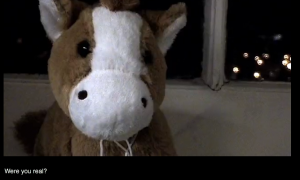 There is also the existence of SNUs that are not a common occurrence having only one ‘in’ link, for example a stuffed horse toy with the caption, “Were you real?” This technique keeps the piece fresh and a constant discovery.
There is also the existence of SNUs that are not a common occurrence having only one ‘in’ link, for example a stuffed horse toy with the caption, “Were you real?” This technique keeps the piece fresh and a constant discovery.
Closely under the main pane, text is sharply contrasted in white against the black background. The content of the text is not a direct reflection of what is happening in the clip, but it does form some relationship; for example when the text states, “Maybe there was something there,” we see a blurry shot we can’t clearly make out.
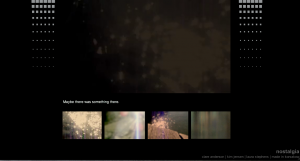
Furthermore, the lines of text also begin to form a collection of feelings, ideals and emotions. For example, “Just waiting patiently trying to conform,” could relate to acceptance, “I wonder if you’ll still shine like you did before,” hope, “I found it hard to draw the line between the chaos outside myself and the chaos within,” the constant struggle of the human psyche. Ian Bogost emphasises the importance of lists as they, “remind us that no matter how fluidly a system may operate, its members nevertheless remain isolated, mutual aliens.” In the piece the text explains an emotion of the moment and isolates it from any other feeling.
As Adrian notes in his write up on the project, the ability to click away from the opening credits and get started on watching the film shows an, “awareness of the user as a consequence.” It not only makes the piece driven on the audience’s character (as some will not have the patience to wait; while others will happily ponder) but also makes the audience feel like they have more control over the project. The main video pane is housed in the middle of the screen, with a line of text closely under and four smaller linking thumbnails below. The interface is well balanced and the centrality creates a direct user experience therefore commanding attention to the main screen. There is a simplicity and neatness which makes navigation of the interface seamless, providing a juxtaposition of an ordered image to an unmethodical collection of thoughts and emotions portrayed in the work. It’s also interesting to note that clips do not repeat after they have been played or begin to play when you hover your mouse over the linking SNU. This serves the ideal of capturing something in a moment; in life you don’t get the option to relive something exactly over again so it wouldn’t seem appropriate to here.
Nostalgia uses a black background with a geometric square pattern graphic symmetrically placed on each side of the main player as a canvas for the project. The graphics provide a frame for the work, directing the viewers’ attention and also adding depth. The effect is almost a filtered look as the squares fall down the page to get smaller and smaller, this could relate metaphorically to the formation of links in the Korsakow project as it begins broadly and then becomes more and more connected, or it could relate to water as it looks like rain falling.
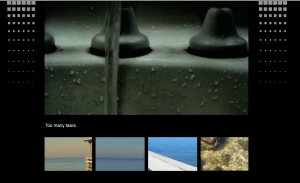
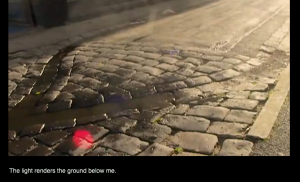
A main theme throughout the piece is the subject matter of water – a universal code for youth and life’s beginning – it not only emotes the feeling of nostalgia but adds a rhythm in its fluidity. Water is also commented on in the text, as “Drowning without being submerged,” and “Too many tears,” plays on the ideal. In the project, the manner in which different shots are filmed elicits different emotional ploys, such as the adjusting focus shot of, “The light renders the ground below me,” creating the effect of just waking up to the beginning of something.
The shots are very poetic and most of the time they never show content in full view, always being parts of objects; like feet or a pier. There is also a lack of people in the shots or more so not a focus on them, this allows a more personal experience with the work and also emphasises shots like, “I searched for comfort in other people’s faces.” In this shot we see people but don’t connect with them as they simply pass by, establishing a sense of isolation.
Music is crucial to the piece, with a different track played with each clip. The music is un-lyrical which allows it and the text to form a relation in creating some sort of song. Adrian does question whether a single continuous soundtrack would have been more effective, and even though it does get a little clunky having to wait for the new music to start and videos to load, it’s worth it as each track asks for a different emotional response from the viewer, drawing them into this evolution of thought and feeling. Music is also used to evoke emotion, for example piano music used in more sombre clips of the piece.
Throughout the work the average duration of clips is not long, relating to the idea of memories not encompassing long sequences but when accessed in our thoughts are simply snippets of moments. After thorough navigation of the piece you realise there is no ending SNU, the clips loop on infinitely; as a mind would. All these techniques promote the idea of the project representing the evolution of thought and memories, but I believe the film is trying to represent the more sombre; the ideal of nostalgia not being able to bring back moments but simply redefine loneliness.
References
Anderson, Clare; Jensen, Kim and Stephens, Laura. “Nostalgia.” Korsakow. 2010: http://vogmae.net.au/classworks/media/2010/kfilms/nostalgia/, March 2014. (screen shots and text quotes)
[Extract] Bogost, Ian. Alien Phenomenology, or What It’s Like to Be a Thing. Minneapolis: University Press of Minnesota, 2012. Print.
Bordwell, David and Kristin Thompson. Film Art: An Introduction. New York, N.Y.: McGraw-Hill, 2013. Print.
Miles, Adrian. “Nostalgia.” Classworks – Interactive online video work by media undergrads. 2010: http://vogmae.net.au/classworks/2010/Nostalgia.html
Film-TV1- 2.2 Story Synopsis
For Story Idea Number Four
Jeff goes to the dry cleaner to pick up his mum’s clothes, upon discovering that his high school crush, Essie, works there. Rejuvenated with the love he once had for her Jeff can’t stop thinking about Essie and knows the only way he can see her without it being totally contrived is at the dry cleaner. He then makes an effort to dirty his clothes in any way possible in order to have an excuse to visit her; that means wiping his food ridden hands on white shirts, being sure to never seek cover in the rain and being a friend to his best mate’s dog. Essie is surprised by how many clothes Jeff has to get cleaned and sometimes asks for an explanation, to which Jeff comes up with a believable response. One day Jeff comes in wearing a dirty jacket and Essie insists on cleaning it on the house due to all his dry cleaning keeping the place in business. Jeff gives her his jacket completely forgetting that he has left his list of ‘Dirty Clothes Excuses’ he has been checking off in his breast pocket. As soon as Jeff leaves Essie cleans his pockets and finds the note to which she laughs and realises he must really like her in order to go to so much trouble to see her. She decides to clean the clothes and take them home, because she’s not going to come into work tomorrow. The next morning Jeff stops by the dry-cleaner and is let down Essie isn’t working; being a little surprised his clothes aren’t ready for collection. He gets home and finds his dry cleaned clothes on his doorstep with a note saying “Do you have an excuse for 6pm? – Essie” and his list attached.
